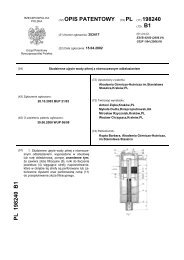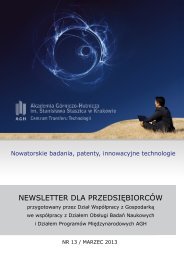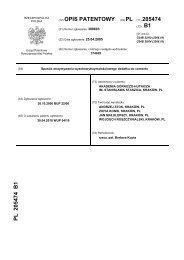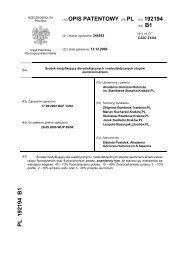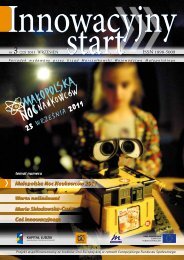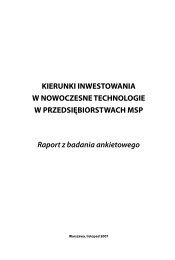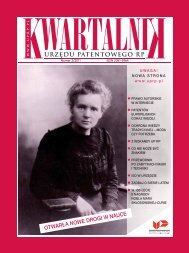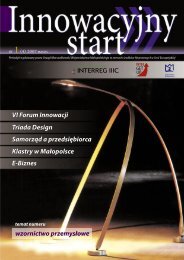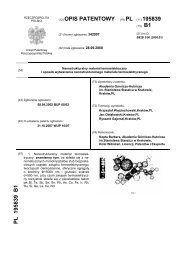Wyd. specjalne/2011 - Regionalny OÅrodek Informacji Patentowej ...
Wyd. specjalne/2011 - Regionalny OÅrodek Informacji Patentowej ...
Wyd. specjalne/2011 - Regionalny OÅrodek Informacji Patentowej ...
- No tags were found...
Create successful ePaper yourself
Turn your PDF publications into a flip-book with our unique Google optimized e-Paper software.
wzorów przemysłowych w prawie europejskim”Europejski Przegląd Sądowy 1/2007).Meanwhile, A. Tischner (A. Tischner “Prawowłasności przemysłowej. Komentarz.” ed.P. Kostański, Warsaw 2010) maintains that“an informed user may be a user of specificproducts or somebody knowing a specificsector covering products to which the designbelongs, in particular a user aware of the currentdevelopments of design in specific fieldof production.” User’s knowledge may resultfrom long-term constant use of specificproducts. K. Szczepanowska-Kozłowska(“Zdolność rejestracyjna wzoru w prawie UniiEuropejskiej, PPH no 3 of 2005) is of a differentopinion. She limits the scope of a termof informed users to final consumers for whomthe product is intended. In the judgmentof 23 October 2007, in Case II CSK 302/07,the Supreme Court adopted an interpretationof the notion of “informed user” demonstratingthat it should take into account the EuropeanUnion case-law acquis in cases regardinginvalidation of industrial designs and in casesof protection of rights in registration of industrialdesigns. The Supreme Court maintained thatliteral interpretation of the notion in question“demonstrates that a well-informed personis a user having good insight in and knowledgeof a given area, using specific items or a groupof items”. The notion is not abstract but refersto a specific group of items subject to comparison,to which the item registered as industrialdesign and the question item belong. (…)The opinion that informed user is a personusing given items permanently, having morepractical or theoretical information regardingthe items than the average user and havinggreater ability to notice the distinctive featuresof a given item than the average user, prevailsin the EU literature and case-law. Consequently,the “informed user” is a person with practicalor theoretical knowledge of the developmentsof design in a given area and with the abilityto distinguish the designs”. The VoivodeshipAdministrative Court defined the “informeduser” in a similar way and demonstrated thata person looking at skirting boards oncethey have been sealed is not the “informeduser” of skirting boards. The informed useris the person seeking the skirting board, lookingat it in a shop “from the top, from the bottom,holding it, taking a close look, studyingthe “front” longitudal elements and “tunnels”for cables at the back”. (judgementof the Voivodeship Administrative Court in Warsawof 10 October 2007, VI SA/Wa 1116/07).Case-law of the Polish Court for the CommunityTrade Marks and Community Designssupports the concept of the “informed user”as presented by M. Poźniak-Niedzielska. Inthe judgement of 8 October 2007, in CaseXXII GWwp 2/05, the Court found that the informeduser is the experienced employeeof a shop with building materials or a repairand construction company. Such a personis well-informed on the market offer and canrecommend a product manufactured in compliancewith a model satisfying the client’s tasteand expectations (relating to its appearance).”In a different judgement, the said Court concurredwith the above mentioned assumptionthat the “informed user of a promotional penwould be somebody involved in:– distribution of goods of this kind, familiar withthe market offer, able to compare and selectthe product manufactured in compliance withthe model satisfying the taste and expectations(relating to its appearance) of the final user,– promotion and advertising in a company,with the knowledge of the market and experiencein the selection of products facilitatingthe most effective implementation of objectivesrelating to promotion of the trademark, tradename or another mark used for the purposesof business activity”. (judgement of the Courtfor the Community Trade Marks and CommunityDesigns of 17 March 2008, in Case XXIIGWwp 1/07).Scope of creative freedomPursuant to the provisions in force, assessmentof individual character of an industrialdesign takes into account the scope of creativefreedom accompanying the developmentof a design. This provision expresses the rulethat the more the freedom of a designer developingthe design is limited, the greater attentionshould be paid to minor differences or modifications.Thus the informed user may be expectedto pay greater attention to details. Legalliterature demonstrates that “creative freedomis usually determined by the character and purposeof a product to which the design pertains,as well as local or national social conventionsand aesthetic criteria (...) – which for examplerelates to conditions of use of a given colour,geometric form, image, character, etc.(M. Poźniak-Niedzielska “Prawo własnościprzemysłowej…”). The scope of creative freedomis also limited by functional, constructionaland practical features of an item, as well asprevious design and regulations on safety(K. Wernicka “Nowość i indywidualny charakterwzoru przemysłowego w praktyce Urzęduds. Harmonizacji Rynku Wewnętrznego, EPS,August 2008).Pursuant to the case-law of the SupremeCourt, “the scope of creative freedom is determinedby the functional features of the itemand by previous design”. When designs haveto involve mainly the functional requirementsof the item, the scope of creative freedomis narrower than for designs predominatedby aesthetic conditions. When the scopeof creative freedom is wider, the differencesbetween the designs should be easier to observethan when the scope of this freedomis narrower. An informed user must beinformed in this area sufficiently enough to assessthe scope of creative freedom and mustbe able to notice even the relatively minor differences,which are yet significant in the caseof designs with little creative freedom” (judgementof the Supreme Court of 23 October2007 in Case II CSK 302/07).The test of “creative freedom accompanyingthe development of a design” means thatwhen there is slim possibility of introducingmodifications, relatively small differencesare required to assess individual character;and on the contrary, when creative freedomis greater, the differences required to assessthe individual character are greater. (J. Kępiński“Wzór przemysłowy….”). The issue of a narrowscope of creative freedom connected withthe functional products (skirting boards) wascommented by the Court of Appeal in Warsaw,in its judgement of 10.10.2007, in Case VISA/Wa 116/07: “when a product’s appearanceclosely relates to its functional features,the scope of creative freedom is narrow.However, when possibilities to introduce modificationsare minor, relatively small differencesare required to assess individual characterof a design”.To sum up, the notions of novelty and individualcharacter are two basic conditionsof protection of industrial designs. These termsare very general, which means that the legislatorprovided the possibility for their broad interpretation.Bearing in mind the above considerations,interpretation of the notions in questionis largely affected by legal literature and Polishand Community case-law, which will probablybecome increasingly extensive in this regarddue to great interest in industrial design.Małgorzata BarankiewiczEdyta Demby-Siwek50 • KWARTALNIK URZĘDU PATENTOWEGO RP <strong>Wyd</strong>anie <strong>specjalne</strong>




